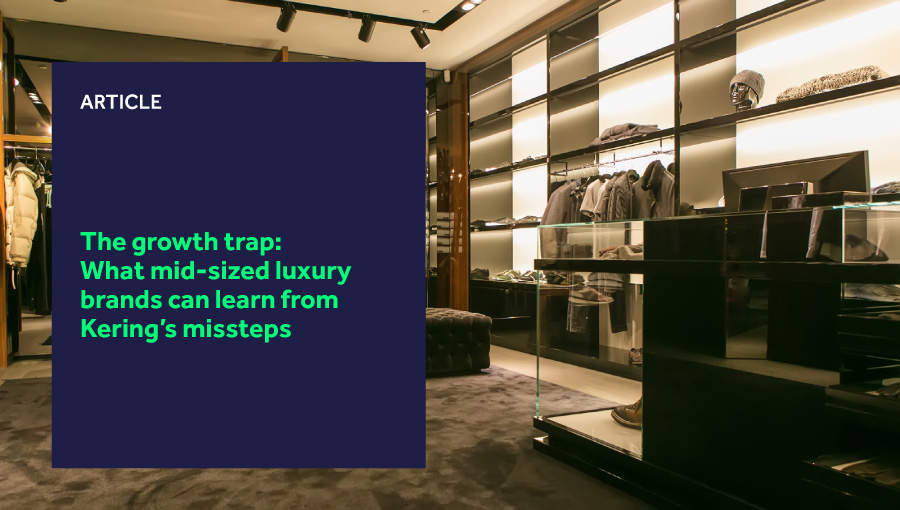When luxury fashion stumbles, the fall is rarely graceful. While several incumbents have proved to be more than resilient, Kering’s missteps serve as a cautionary tale for mid-market brands.
Once flying high on the back of Gucci’s maximalist renaissance, the group now grapples with sliding sales, bruised investor confidence, and a debt load that could trigger its third credit downgrade in as many years.
This isn’t a headline for the big players. It’s a mirror for the wider industry.
Kering’s downward spiral reveals something deeper, that being how even the most successful brands can unravel when strategy outpaces structure.
For mid-sized brands with ambitions of global scale, this warning is stark.
What went wrong for Kering: A brief autopsy
Following Gucci’s post-pandemic slowdown, Kering went into overdrive. It acquired Creed for €3.5 billion, took a $1.9 billion stake in Valentino, and invested heavily in prestige real estate.
Kering even bought into Hollywood via talent agency CAA.
The problem with its aggressive expansion, however, was that much of it was debt-financed. By 2024’s close, Kering’s net debt ballooned to €10.5 billion, roughly half the group’s market value.
These bets coincided with a 24% plunge in Gucci sales in late 2024 and a 30% fall in group free cash flow. Kering’s share price dropped 60% over two years, and its leverage ratio (debt/EBITDA) hit 3.8x, which is dangerously close to triggering a third credit downgrade.
Consequently, the company has been forced to cut costs, sell properties, and face looming liabilities, such as the additional €4 billion it may owe to acquire the rest of Valentino.
Kering wasn’t wrong to try to escape the slowdown, but it lacked the operational backbone to absorb, integrate and capitalise on the acquisitions, creating the mess it now finds itself in.
The mirror for mid-market luxury brands: Same game, smaller stakes
Much like Nike in the footwear arena, Kering, and by extension Gucci, will eventually find a path forward out of their strategic missteps. But that doesn’t detract from the lessons that mid-sized brands should learn from their mistakes.
Mid-sized luxury brands might not be purchasing Parisian flagships or billion-dollar beauty houses, but many are making scaled-down versions of the same errors:
- Expanding into new categories and markets before their core operations are ready for expansion.
- Relying on gut feel and legacy systems (or even spreadsheets) instead of real-time insight.
- Opening expensive stores with under-optimised inventory control that erodes margins.
- Hiring rapidly without unified systems for sharing data between departments or business entities.
The strategy may indeed look solid on paper, but it ultimately collapses under pressure.
Just like Kering, smaller brands are susceptible to growth that turns brittle when it isn’t underpinned by control.
Kering’s crisis is a case for fashion ERP
Kering’s troubles weren’t caused by a lack of data. The group and its subsidiaries, such as Gucci, rely on well-established ERPs across most of their business. The issue wasn’t visibility but usability.
Despite having access to data on inventory, cash flow, and supplier performance, Kering made aggressive strategic decisions that suggest these insights weren’t fully leveraged.
There was a disconnect between information and action.
Gucci’s slowdown wasn’t hidden. Real estate risk wasn’t unknowable. Yet the company continued to scale, spend and diversify without a clear operational anchor.
This is where fashion-specific ERPs, paired with the right strategic guidance, become genuine growth enablers, especially for mid-sized luxury brands.
Modern fashion ERPs offer more than operational backbones, they offer clarity:
- Real-time product lifecycle visibility
- Supply chain and inventory transparency
- Multichannel sales analysis
- Margin control by SKU, category, or region
- Operational alignment across teams
This is the kind of control Chanel, Hermès, and LVMH have institutionalised:
- Chanel increased capex by 43% in 2024 to fortify its supply chain
- Hermès raised prices while expanding artisan capacity by 6–7%
- LVMH leveraged cash reserves to reinforce, not overextend
These incumbents ultimately invested from a place of insight and acted on information.
By contrast, Kering seemingly took on more than it could see and is now paying the price. Its systems may have been in place, but the strategic application of those insights fell short.
Build your backbone before your brand outgrows it
Kering’s cautionary tale is rooted in timing. Its acquisitions came just as the luxury cycle was softening globally. Interest rates were rising. Debt became more expensive. Creative leadership at Gucci was shifting. There was no stable foundation to support the strategic sprint.
Mid-sized brands must be careful not to avoid the same strategic misfires that have led to the downturn in incumbents like Gucci and Nike. Brand heritage alone doesn’t guarantee success.
The reality is that if your operations aren’t well-knit, scaling amplifies dysfunction. If teams aren’t aligned by data, decisions get slower and riskier. If margins aren’t available in real-time, finance flies blind in a volatile market.
Fashion ERPs aren’t necessarily a magic fix, but they ensure the engine behind your brand doesn’t stall at the worst possible moment.
From aspiration to execution
Luxury fashion isn’t short of ambition, but in this market, where consumer behaviour shifts fast, economic pressures continue to intensify, and even the biggest brands falter, ambition alone isn’t enough.
The winners won’t necessarily have the boldest campaigns, the loudest logos, or the flashiest flagships. They’ll be the brands that execute.
Execution is what turns vision into value.
Fashion ERPs won’t suddenly make your brand desirable. That’s your job.
But they will give you the visibility, control and alignment to grow on your terms while avoiding the pitfalls that brought giants like Kering down.
If you’d like to learn more about how fashion ERPs can help your brand, feel free to drop us a line today.
 https://k3fashionsolutions.com/wp-content/uploads/2025/10/discipline-behind-desire-featured.jpg
510
900
Jordan Heal
https://k3fashionsolutions.com/wp-content/uploads/2024/12/K3_Fashion_Solutions_Half-color_RGB.svg
Jordan Heal2025-10-14 15:17:472025-10-14 15:17:47The discipline behind desire: How operational rigour defines modern fashion
https://k3fashionsolutions.com/wp-content/uploads/2025/10/discipline-behind-desire-featured.jpg
510
900
Jordan Heal
https://k3fashionsolutions.com/wp-content/uploads/2024/12/K3_Fashion_Solutions_Half-color_RGB.svg
Jordan Heal2025-10-14 15:17:472025-10-14 15:17:47The discipline behind desire: How operational rigour defines modern fashion


